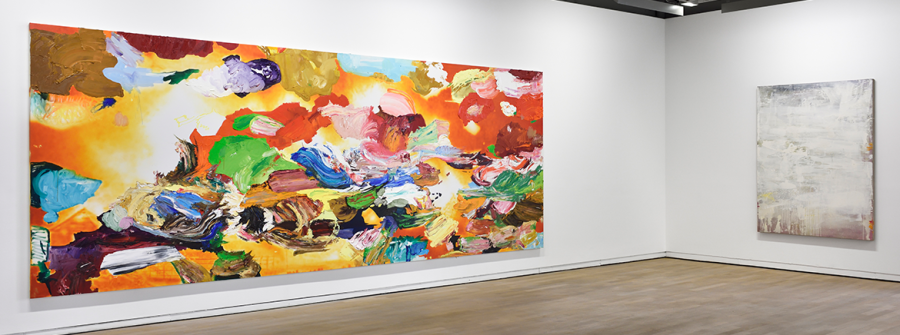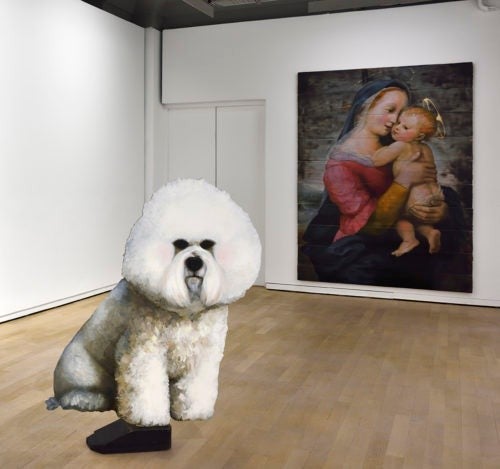Bianco Bichon, Nero Madonna e altre distruzioni liriche

Everything started at the beginning of the 2000s through an accumulation process and an empirical practice in the studio, and yet for Tursic and Mille, doing is primarily a matter of thinking, defining how they produce and think in painting.
In reference to the lecture that concluded Maurice Merleau-Ponty’s 1960-61 course at Collège de France, the artists define this as a true love letter addressed to painting. More particularly, the primacy of perception1 asserted in the French philosopher’s phenomenology seems to have become the everyday material of the artists’ work in the studio, both in their exploration of a language that gets redefined every time in the very act of formulating a new thought, and also in the dynamic relationship between everything that gives rise to their work: consciousness, the world, history and their interpersonal relations. An art of doing (with their hands) and thinking (with their heads). And a kind of painting, which also raises the question of how two people can paint together, with the superimpositions, interpenetrations, complementarities and contradictions that follow from a constitutive division in two. It is a question of proximity, and therefore of reaction, desire: “The fact of having two heads and two right hands can prove very useful, in many situations!”
So it is a theoretical painting practice that determines what must be done through the very fact of thinking of how to do it, accommodating a wide spectrum of possibilities continuously presented by this decision process, which is constantly opened and solicited. By mainly reproducing found images, the question is not “this OR that”, but rather “this AND that”, according to a principle of critical accumulation (discussed and judged case-by-case) and perpetual motion. This means that Tursic and Mille’s paintings do not reflect a particular style, and that they are neither abstract nor figurative, but are at most both at the same time; because every style and every subject is “within reach” as they themselves assert, since: “panting cannot be a gesture set in stone and filed like patent. It must be open to all the propositions its practice generates; painting must be opportunistic and self-conscious.”
Tursic and Mille’s exhibition at Fondation d’entreprise Ricard is yet another revision of these propositions and a new open, continuous love letter to painting itself. Starting with its title, which references the two opposite colors black and white, as well as the coexistence of two subjects, the bichon frise (a breed of dog) and the Madonna (the most classic pictorial subject): the former, moreover, rendered like a painting within a painting and the latter painted and then burned, the residue of a production process that simultaneously proposes and disfigures (alters, eliminates, or at the very least couples, juxtaposes) the image preliminarily chosen.
Another work presented, an XXL painting depicting the ruins of the Hollywood sign, painted directly on the walls of the studio, in something like an ancient sinopia, bears traces of the artists’ work, the ghost of earlier pieces.
And then there is the large wall at the entrance, where an image of the studio shows through, followed by a wall covered with dozens of works on paper and canvas: sketches, plans, first attempts, texts and images… which are more reflections on the fact of painting a painting than paintings as such—in other words, the flow of the act of painting instead of the finished work.
A potentiality as cacophonous as it is joyful: an exhibition and its just-as-innumerable possible variants, the latest of which might be almost exclusively a stroke of luck. Like the images on which other versions are superimposed. Or the bodies, faces, objects, landscapes teeming with patches of pure color.
If this is a spirit that connects Tursic and Mille to contemporary painting while at the same time setting them apart from it, it is indeed a mixture between a digital sensibility pushed to the point of paradox (until it becomes objective and palpable) and a reclaiming of the analogue gesture and material that dematerializes in its possible variants, thus generating a succession of oxymorons: a calculated bet, a welcoming and comfortable excess, a generous opportunism, a conscious unconsciousness, a masterful experiment, a curious and fluctuating culture, pleasure without its explanation, without its mystery being revealed. The space-time of the choice where, by connecting the categories of the mysterious and the supernatural, “a thing becomes a work of art”, as Eric Troncy wrote; a work that gives us the unique chance to really do “the prohibitive experience of art”2. A systematic lyrical destruction in which to reconstruct the painting form and bring the enchantment back to the intellectual and perceptive experience of painting.
1. Maurice Merleau-Ponty, The Primacy of Perception, Northwestern University Press, 1964.
2. Ida Tursic & Wilfried Mille, Decade, 2011. Text by Eric Troncy. Les presses du réel.

